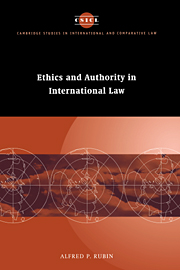Book contents
- Frontmatter
- Contents
- Preface
- Acknowledgments
- List of abbreviations
- Table of cases
- Table of statutes
- Table of treaties
- 1 Introduction
- 2 The international legal order
- 3 Theory and practice come together
- 4 Putting it together
- 5 Implications for today
- Bibliography
- Index
- CAMBRIDGE STUDIES IN INTERNATIONAL AND COMPARATIVE LAW
5 - Implications for today
Published online by Cambridge University Press: 14 September 2009
- Frontmatter
- Contents
- Preface
- Acknowledgments
- List of abbreviations
- Table of cases
- Table of statutes
- Table of treaties
- 1 Introduction
- 2 The international legal order
- 3 Theory and practice come together
- 4 Putting it together
- 5 Implications for today
- Bibliography
- Index
- CAMBRIDGE STUDIES IN INTERNATIONAL AND COMPARATIVE LAW
Summary
“Solutions” in a positivist legal order
“Legislating” a new constitution piecemeal
The simplest “solution” to the fact that ethical standards are not enforceable directly by the administrators of public international law, whether states in diplomatic correspondence or institutions or others, is to create a structure within the international legal order by the usual means available to “positivist” jurists. Of course, that requires states or belligerents or others sought to be bound by the new structure to consent to it. In some cases, that has been done very successfully. In Europe, major steps have been taken to modify the existing state structure by the creation of a single economic entity whose legislative and enforcement authority is, by agreement of the member states in the usual Westphalian pattern, given to new institutions organized specifically for the purpose of receiving and exercising the new authority. In the “human rights” area, the Council of Europe's Human Rights Commission and Court serve as outstanding examples. General principles have been agreed among the state parties and an institutional structure has also been agreed with responsibility and authority to interpret those principles as they might apply to specific cases; provision has been made allowing appropriate cases to be brought. Similar institutions have been proposed in other contexts. The results vary with the willingness of the states involved to accept the sort of institutional structure that would actually implement agreed human rights principles.
- Type
- Chapter
- Information
- Ethics and Authority in International Law , pp. 170 - 206Publisher: Cambridge University PressPrint publication year: 1997

